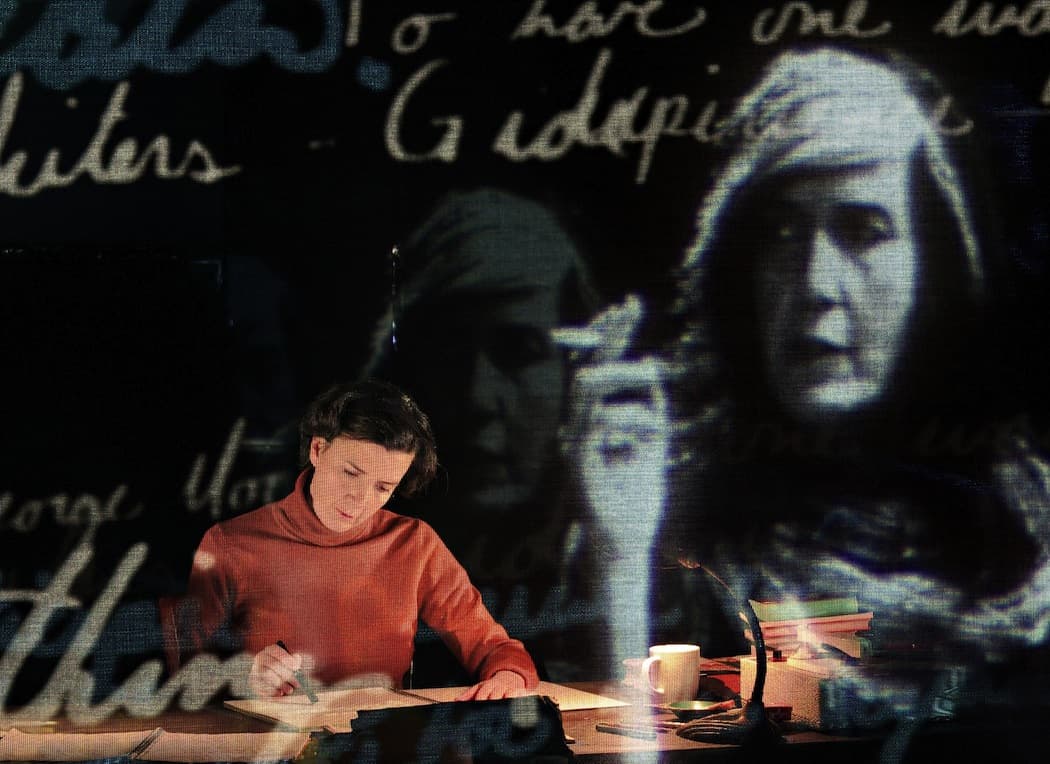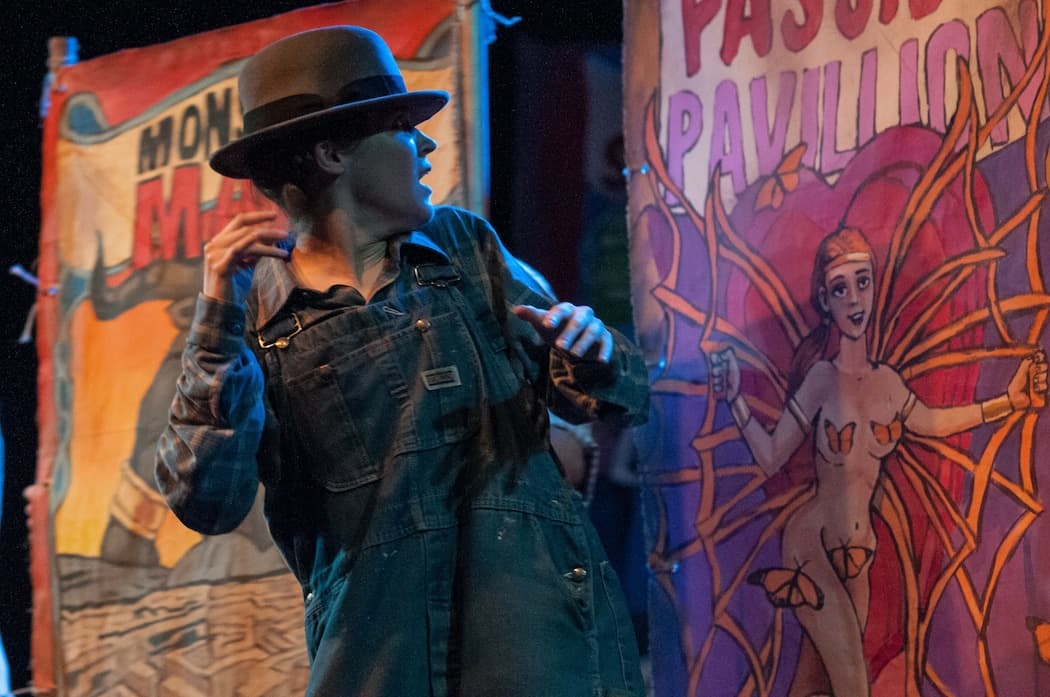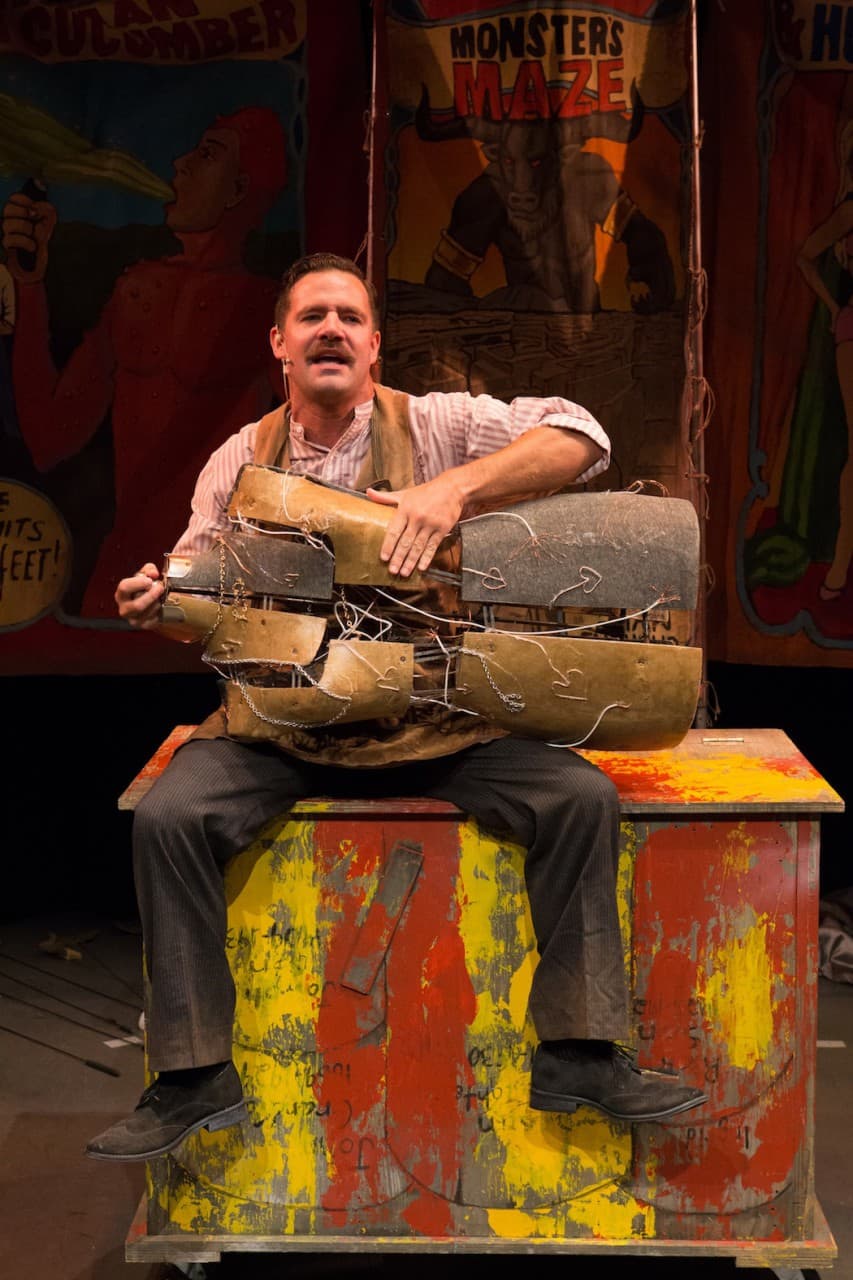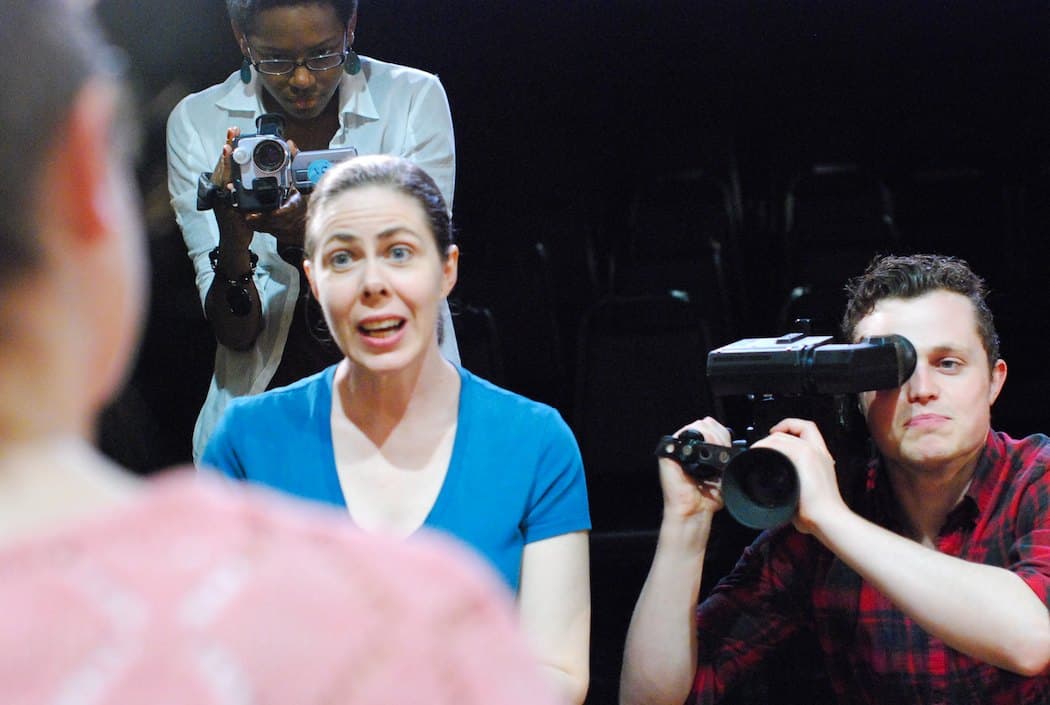Advertisement
3 Theatrical Ways Of Telling A Story, Starting With Sontag
BOSTON – For Susan Sontag the ideal work of art — really, any work that should be considered art — was one in which form and content were so closely tied that they were virtually the same thing. Think Stanley Kubrick movies, Beethoven symphonies, T.S. Eliot poetry. The idea that content — what a work means — could be isolated and critically biopsied was anathema.
I think she would have liked The Builders Association’s one-woman show, “Sontag: Reborn,” in which a projection of the older Sontag looks on as the younger woman struggles with sexual and literary identity through the 1950s and ‘60s. It’s quite a lovely piece from ArtsEmerson (at the Paramount through May 18) though it’s difficult for me to say how much interest it will be for those not particularly interested in the critical response to art, particularly 20th century art.
The central contrast actress Moe Angelos and director Marianne Weems create beween the older chain-smoking, silver-streaked, dispassionate, confident Sontag and the young omnivorous, colorful, passionate, self-doubting Sontag is riveting. Angelos and Weems have found the perfect visual metaphor for Sontag looking back over her life, and in fact Sontag did frequently go over her journals.

"In the journal I do not just express myself more openly than I could in person,” she said. “I create myself." So what we have here is witnessing Sontag trying to fight off her lesbianism in the ‘50s before leaving her marriage and throwing herself whole-heartedly into the world of women instead of men and intellectual lustiness instead of domestic dutifulness.
The Builders Association was at ArtsEmerson last year with “HOUSE / DIVIDED,” kind of “Grapes of Wrath” meets “Too Big to Fail,” and there’s a similar blend of audio, video and what they term architectural effects to enhance the always fascinating tossings and turnings of Sontag’s cultural ruminations and self-examinations. The deliberately heavy miking, as in “H/D,” creates a stridency in Angelos’s delivery that isn’t always pleasant to listen to. And her watusi-ing probably won’t land her on “Dancing with the Stars.”
That, too, could be for effect, as the younger Sontag thrashes about while one screen shows more controlled dancers and an increasingly magnified projection of the black and white Sontag declares “Style is the signature of the artist’s will” on the scrim.
I don’t know that Sontag ever crossed the line from critic and observer to artist, but “Sontag: Reborn” makes a very stylish and artful case that Sontag’s writing is a crucial part of how we can and should think about art today.
Icarus

ArtsEmerson and the American Repertory Theater are both national masters in the theatrical school of telling stories differently — using audio, video, movement, puppets, lavish sets, etc. to advance the story — rather than relying primarily on the text.
The problem is that you often need millions of dollars to throw at an A.R.T. or ArtsEmerson project. Jason Slavick, artistic director of Liars & Believers, subscribes to those more kinetic modes of storytelling, but doesn’t want to let the rich folks — the relatively rich folks, we should say — have all the fun. (He has also credited them with leading the way.)
A.R.T. has taken Liars & Believers under its wing, giving it artists in residence status at its second stage, OBERON, and Slavick has responded with a duly fanciful and enjoyable “Icarus” (through Sunday), less an update of the flying-too-close-to-the-sun myth than a riff on breaking away and generation gaps.

This marks the return of “Icarus” to Cambridge, following performances at last summer’s Outside the Box festival as well as in New York. The setting is a traveling, sinister-seeming circus run by Minnie Minosoczeck during the Depression. Her daughter, Penny, is the star “flying” attraction, wooed by Icarus, whose father, Daedalus, is the mechanic with a dark secret of his own.
The story, though, is advanced as much by Nathan Leigh’s pleasant indie-rock music performed by the trio, Store Bought Absinthe, and Faye Dupras’ puppets. One of the most effective moments in the one-act show is the depiction of an out of work alcoholic, represented by a bag of empty clothes who is then walked offstage.
If I were you, I’d also get there a half-hour beforehand for the pre-show concert, which features a local band and, the night I went, a pair of twirling-twerking women, one flirting with a bed of nails, setting an atmospheric tone amid the cabaret seating. In some ways the non-story of the pre-show felt more adventurous, certainly more pulsating, than the story itself. (The entertaining, energetic Emperor Norton's Stationary Marching Band was playing the night I went. See Greg Cook's story.)
“Icarus” is an interesting spin on the myth, but at heart it’s a tried-and-true “We gotta get out of this place” story of parents trying to hold on to their children and the latter rebelling. In this case, Minnie (Aimee Rose Ranger) preaches a Social-Darwinian “eat or be eaten” gospel that keeps Icarus and Penny all but enslaved to the circus.
Here's Ranger as Minnie. The rest of the cast is different except for her and Veronica Barron.
Slavick’s direction is solid and the acting is too. I’d like to see the troupe take the form even further — except for that bag of clothes, the emotional high points rely more on over-boiled acting than singular stagecraft. Still, it’s good to see Liars & Believers and other smaller local companies take up the mantel from A.R.T. and ArtsEmerson.
Good Television

If those companies throw everything but the kitchen sink at theater in trying to find new forms and win over younger audiences, David Miller and Zeitgeist Stage Company are often happy with just the kitchen sink, the term for drama that uses more realistic settings.
And he’s very good at it, as witnessed by his Elliot Norton Award nominations for “Punk Rock” and “The Normal Heart.” I wouldn’t use the latest Zeitgeist production, Rod McLachlan’s “Good Television,” to make his case, though.
Connie Cuellar is the field producer for a reality TV show that promises intervention and rehab for addicts “lucky” enough to be chosen for the show — as long as they don’t know the terms in advance.
So off she and two others go to a trailer-trash family where they will all, along with the executive producer back home, debate ad nauseam the morality of what they’re doing.
All, that is, except the addict who only cares about his next fix while sitting on a powderkeg of secrets that gives "Good Television" a silly semblance of drama. The dissection of reality television also doesn't ring true as the whole raison d’etre of that form is the producers’ amorality combined with the contestants’ eagerness to trade humiliation for celebrity.
Add in wooden “lifestyles of the earnest and self-righteous” dialogue that showers the cast in splinters except for Olev Aleksander as the amoral older brother and Ben Lewin as the addict and “Good Television” just isn’t very good theater.
More on Susan Sontag




